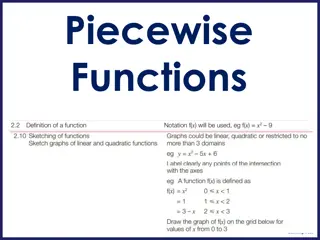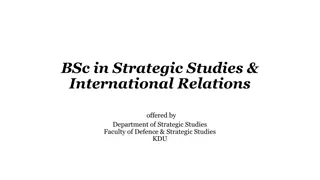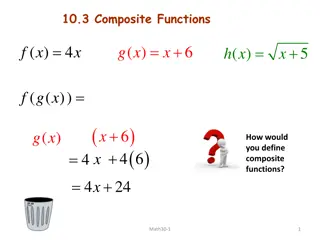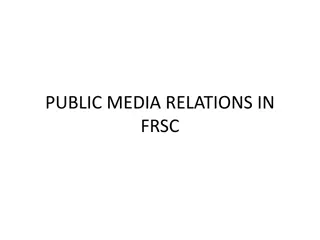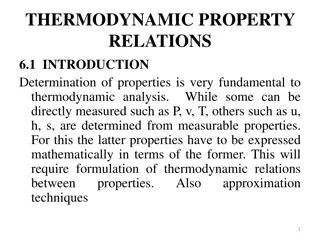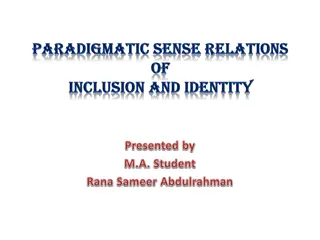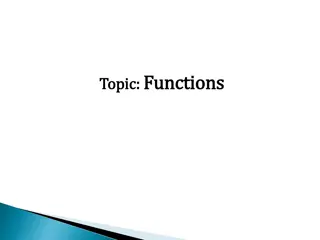Understanding Relations and Functions in Mathematics
This chapter explores various types of relations and functions, including empty and universal relations, equivalence relations, and common errors in understanding symmetry. It also delves into the concept of reflexivity, symmetry, and transitivity in relations, with practical examples provided for better comprehension.
Download Presentation

Please find below an Image/Link to download the presentation.
The content on the website is provided AS IS for your information and personal use only. It may not be sold, licensed, or shared on other websites without obtaining consent from the author. Download presentation by click this link. If you encounter any issues during the download, it is possible that the publisher has removed the file from their server.
E N D
Presentation Transcript
CHAPTER-1 RELATIONS AND FUNCTIONS CLASS-XII BY DR. G C SARANGI (P.G.T.,MATHS) D.A.V. PUBLIC SCHOOL, BERHAMPUR.
INTRODUCTION Recall that the notion of relations and functions, domain, co-domain and range have been introduced in Class XI along with different types of specific real valued functions and their graphs. The concept of the term relation in mathematics has been drawn from the meaning of relation in day-to-day life. Let A be the set of students of Class XII of a school and B be the set of students of Class XI of the same school. Then some of the examples of relations from A to B are (i) {(a, b) A B: a is brother of b}, (ii) {(a, b) A B: a is sister of b}, (iii) {(a, b) A B: age of a is greater than age of b}, (iv) {(a, b) A B: total marks obtained by a in the final examination is less than the total marks obtained by b in the final examination}, (v) {(a, b) A B: a lives in the same locality as b}. However, abstracting from this, we define mathematically a relation R from A to B as an arbitrary subset of A B. If (a, b) R, we say that a is related to b under the relation R and we write as a R b. In general, (a, b) R, we do not bother whether there is a recognisable connection or link between a and b. As seen in Class XI, functions are special kind of relations. LEARNING OBJECTIVES In this chapter, we will study different types of relations and functions, composition of a functions, invertible functions .
TYPES OF RELATIONS In this section, we would like to study different types of relations. We know that a relation in a set A is a subset of A A. Thus, the empty set and A A are two extreme relation. For example:- consider a relation R in the set A = {1, 2, 3, 4} given by R = {(a, b): a b = 10}. This is an empty set, as no pair (a, b) satisfies the condition a b = 10. Similarly, R = {(a, b) : | a b | 0} is the whole set A A, as all pairs (a, b) in A A satisfy | a b | 0. These two extreme examples lead us to the following definitions. Definition 1:- A relation R in a set A is called empty relation, if no element of A is related to any element of A, i.e., R = A A. Definition 2:- A relation R in a set A is called universal relation, if each element of A is related to every element of A, i.e., R = A A. Both the empty relation and the universal relation are some times called trivial relations. Example 1:- Let A be the set of all students of a boys school. Show that the relation R in A given by R = {(a, b) : a is sister of b} is the empty relation and R = {(a, b) : the difference between heights of a and b is less than 3 meters} is the universal relation. Solution:- Since the school is boys school, no student of the school can be sister of any student of the school. Hence, R = , showing that R is the empty relation. It is also obvious that the difference between heights of any two students of the school has to be less than 3 meters. This shows that R = A A is the universal relation.
EQUIVALENCE RELATION Definition 3:- A relation R in a set A is called Equivalence relation if it is : (i) reflexive, if (a, a) R, for every a A, For example:-mirror image of a person. (ii) symmetric, if (a, b) R implies that (b, a) R, for all a, b A. For example:-perpendicularity,parallelosm,congruency , similarity,equality etc. COMMON ERROR:-Brother hood & Sister hood (of) are not symmetric in common i,e in set of human beings,but they are symmetric in the set of male & female human beings respectively. (iii) transitive, if (a, b) R and (b, c) R implies that (a, c) R, for all a, b,c A. For example:- congruency,similarity,equality,congruence modulo on the set of integers etc. EXCEPTIONS :-R= {x: x is the wife of y } is .neither reflexive nor symmetric but transitive
EXAMPLES OF EQUIVALENCE RELATION Example 1: Let T be the set of all triangles in a plane with R a relation in T given by R = {(T1, T2) : T1 is congruent to T2}. Show that R is an equivalence relation. Solution: R is reflexive, since every triangle is congruent to itself. Further, (T1, T2) R T1 is congruent to T2 T2 is congruent to T1 (T2, T1) R. Hence, R is symmetric. Moreover, (T1, T2), (T2, T3) R T1 is congruent to T2 and T2 is congruent to T3 T1 is congruent to T3 (T1, T3) R. Therefore, R is an equivalence relation. Example 2:- Let L be the set of all lines in a plane and R be the relation in L defined as R = {(L1, L2) : L1 is perpendicular to L2}. Show that R is symmetric but neither reflexive nor transitive. Solution:- R is not reflexive, as a line L1 can not be perpendicular to itself, i.e., (L1, L1) R. R is symmetric as (L1, L2) R L1 is perpendicular to L2 L2 is perpendicular to L1 (L2, L1) R. R is not transitive. Indeed, if L1 is perpendicular to L2 and L2 is perpendicular to L3, then L1 can never be perpendicular to L3. In fact, L1 is parallel to L3, i.e., (L1, L2) R, (L2, L3) R but (L1, L3) R.
Example :-3 Show that the relation R in the set {1, 2, 3} given by R = {(1, 1), (2, 2), (3, 3), (1, 2), (2, 3)} is reflexive but neither symmetric nor transitive. Solution:- R is reflexive, since (1, 1), (2, 2) and (3, 3) lie in R. Also, R is not symmetric, as (1, 2) R but (2, 1) R. Similarly, R is not transitive, as (1, 2) R and (2, 3) R but (1, 3) R. Example :-4 Show that the relation R in the set Z of integers given by R = {(a, b) : 2 divides a b} is an equivalence relation. Solution:- R is reflexive, as 2 divides (a a) for all a Z. Further, if (a, b) R, then 2 divides a b. Therefore, 2 divides b a. Hence, (b, a) R, which shows that R is symmetric. Similarly, if (a, b) R and (b, c) R, then a b and b c are divisible by 2. Now, a c = (a b) + (b c) is even . So, (a c) is divisible by 2. This shows that R is transitive. Thus, R is an equivalence relation in Z. In the above Example all even integers are related to zero, as (0, 2), (0, 4) etc., lie in R and no odd integer is related to 0, as (0, 1), (0, 3) etc., do not lie in R. Similarly, all odd integers are related to one and no even integer is related to one. Therefore, the set E of all even integers and the set O of all odd integers are subsets of Z satisfying following conditions: (i) All elements of E are related to each other and all elements of O are related to each other. (ii) No element of E is related to any element of O and vice-versa. (iii) E and O are disjoint and Z = E O.
EQUIVALENCE CLASSES & PARTITIONS The subset E is called the equivalence class containing zero and is denoted by [0]. Similarly, O is the equivalence class containing 1 and is denoted by [1]. Note that [0] [1], [0] = [2r] and [1] = [2r + 1], r Z. Infact, what we have seen above is true for an arbitrary equivalence relation R in a set X. Given an arbitrary equivalence relation R in an arbitrary set X, R divides X into mutually disjoint subsets Ai called partitions or subdivisions of X satisfying: (i) all elements of Ai are related to each other, for all i. (ii) no element of Ai is related to any element of Aj , i j. (iii) Aj = X and Ai Aj = , i j. The subsets Ai are called equivalence classes. The interesting part of the situation is that we can go reverse also. For example, consider a subdivision of the set Z given by three mutually disjoint subsets A1, A2 and A3 whose union is Z with A1 = {x Z : x is a multiple of 3} = {..., 6, 3, 0, 3, 6, ...} A2 = {x Z : x 1 is a multiple of 3} = {..., 5, 2, 1, 4, 7, ...} A3 = {x Z : x 2 is a multiple of 3} = {..., 4, 1, 2, 5, 8, ...}
ILLUSTRATIVE EXAMPLE Example 5 :-Let R be the relation defined in the set A = {1, 2, 3, 4, 5, 6, 7} by R = {(a, b) : both a and b are either odd or even}. Show that R is an equivalence relation. Also show that all the elements of the subset {1, 3, 5, 7} are related to each other and all the elements of the subset {2, 4, 6} are related to each other, but no element of the subset {1, 3, 5, 7} is related to any element of the subset {2, 4, 6}. Solution :-Given any element a in A, both a and a must be either odd or even, so that (a, a) R.R is reflexive For a,b A ,(a, b) R both a and b must be either odd or even (b, a) R. hence R is symmetric Similarly for a,b,c A Let (a, b) R and (b, c) R all elements a, b, c, must be either even or odd simultaneously (a, c) R. Hence, R is transitive . Since R is reflexive,Symmetric & transitive.R is an equivalence relation. Further, all the elements of {1, 3, 5, 7} are related to each other, as all the elements of this subset are odd. Similarly, all the elements of the subset {2, 4, 6} are related to each other, as all of them are even. Also, no element of the subset {1, 3, 5, 7} can be related to any element of {2, 4, 6}, as elements of {1, 3, 5, 7} are odd, while elements of {2, 4, 6} are even.
FUNCTION(MAPPING) Definition:- A relation f from a set A to a set B is said to be a function if every element of set A has unique ( one & only one )image in set B. In other words, a function f is a relation from a non empty set A to a non empty set B such that the domain of f is A & no two distinct ordered pairs in f have the same first element. If f is a function from A to B and (a,b) f ,then f(a)=b,where b is called the image of a under f and a is called the pre- image of b under f. TYPES OF FUNCTION Definition:- A function f : X Y is defined to be one-one (or injective), if the images of distinct elements of X under f are distinct, i.e., for every x1, x2 X, f (x1) = f (x2) implies x1 = x2. Otherwise, f is called many-one. Definition :- A function f : X Y is said to be onto (or surjective), if every element of Y is the image of some element of X under f, i.e., for every y Y, there exists an element x in X such that f (x) = y. i,e if range of f = Co-domain of f Definition:- A function f : X Y is defined to be bijective if f is both one-one (injective) & onto (or surjective)
ARROW DIAGRAMS OF DIFFERENT TYPES OF FUNCTIONS f f f X Y X Y X Y a a a 1 1 2 2 b b 2 3 3 c c 4 4 c 3 d d Many-one,Onto(surjective) One-one&onto(bijective) One-one(injective)
ILLUSTRATIVE EXAMPLES Example :- Let A be the set of all 50 students of Class X in a school. Let f : A N be function defined by f (x) = roll number of the student x. Show that f is one-one but not onto. Solution:- No two different students of the class can have same roll number.Therefore, f must be one-one. We can assume without any loss of generality that roll numbers of students are from 1 to 50. This implies that 51 in N is not roll number of any student of the class, so that 51 can not be image of any element of X under f. Hence, f is not onto. Example :- Show that the function f : N N, given by f (x) = 2x, is one-one but not onto. Solution :-The function f is one-one, for f (x1) = f (x2) 2x1 = 2x2 x1 = x2. Further, f is not onto, as for 1 N, there does not exist any x in N such that f (x) = 2x = 1. Example :- Prove that the function f : R R, given by f (x) = 2x, is one-one and onto. Solution:-f is one-one, as f (x1) = f (x2) 2x1 = 2x2 x1 = x2. & f is onto as y= f(x)=2x i,e x=y/2 R i,e co-dom f=range f
Example :- Show that f : N N, given by f(x)= x + 1 ,if x is odd & f(x)=x-1 ,if x is even is both one & onto. Solution:- Suppose f (x1) = f (x2). Note that if x1 is odd and x2 is even, then we will have x1 + 1 = x2 1, i.e., x2 x1 = 2 which is impossible. Similarly, the possibility of x1 being even and x2 being odd can also be ruled out, using the similar argument. Therefore,both x1 and x2 must be either odd or even. Suppose both x1 and x2 are odd. Then f (x1) = f (x2) x1 + 1 = x2 + 1 x1 = x2. Similarly, if both x1 and x2 are even, then also f (x1) = f (x2) x1 1 = x2 1 x1 = x2. Thus, f is one-one. Also, any odd number 2r + 1 in the co-domain N is the image of 2r+ 2 in the domain N and any even number 2r in the co-domain N is the image of 2r 1 in the domain N. Thus, f is onto. Example :- Show that an onto function f : {1, 2, 3} {1, 2, 3} is always one-one. Solution :- Suppose f is not one-one. Then there exists two elements, say 1 and 2 in the domain whose image in the co-domain is same. Also, the image of 3 under f can be only one element. Therefore, the range set can have at the most two elements of the co-domain {1, 2, 3}, showing that f is not onto, a contradiction. Hence, f must be one- one. Example:-Show that a one-one function f : {1, 2, 3} {1, 2, 3} must be onto. Solution:-Since f is one-one, three elements of {1, 2, 3} must be taken to 3 different elements of the co-domain {1, 2, 3} under f. Hence, f has to be onto. Remark(V.IMP.):- The results mentioned in above Examples are also true for an arbitrary finite set X, i.e., a one-one function f : X X is necessarily onto and an onto map .
COMPOSITION OF FUNCTIONS Definition:- Let f : A B and g : B C be two functions. Then the composition of f and g, denoted by gof, is defined as the function gof : A C given by gof (x) = g(f (x)), x A. A B C f(X) g(f(X)) X gof (X)
WORKED OUT QUESTIONS Example :-Let f : {2, 3, 4, 5} {3, 4, 5, 9} and g : {3, 4, 5, 9} {7, 11, 15} be a functions defined as f (2) = 3,f (3) = 4, f (4) = f (5) = 5 and g (3) = g (4) = 7 and g (5) = g (9) = 11. Find gof. Solution:- We have gof (2) = g (f (2)) = g (3) = 7, gof (3) = g (f (3)) = g (4) = 7, gof (4) = g (f (4)) = g (5) = 11 and gof (5) = g (5) = 11. Example:- Find gof and fog, if f : R R and g : R R are given by f (x) = cos x and g (x) = 3x2. Show that gof fog. Solution:- We have gof (x) = g (f (x)) = g (cos x) = 3 (cos x)2 = 3 cos2 x.Similarly, fog(x) = f (g (x)) = f (3x2) = cos (3x2). Note that 3cos2 x cos 3x2, for x = 0. Hence,gof fog. PRACTICE QUESTIONS 1. Show that if f : A B and g : B C are one-one functions,then gof : A C is also one-one . 2. Show that if f : A B and g : B C are onto functions,then gof : A C is also onto function. 3.Consider functions f and g such that composite gof is defined and is oneone. Are f and g both necessarily one-one. 4. Are f and g both necessarily onto, if gof is onto? THEOREM-1 If f : X Y, g : Y Z and h : Z S are functions then ho(gof ) = (hog) of PRACTICE QUESTIONS 1. Consider f : N N, g : N N and h : N R defined as f (x) = 2x, g (y) = 3y + 4 and h (z) = sin z, x, y and z in N. Show that ho(gof ) = (hog) of 2. Consider f : N N, g : N N and h : N R defined as f (x) = 2x, g (y) = 3y + 4 and h (z) = sin z, x, y and z in N. Show that ho(gof ) = (hog) of.
INVERTIBLE FUNCTIONS Definition:-A function f : X Y is defined to be invertible, if there exists a function g : Y X such that gof = IX and fog = IY. The function g is called the inverse of f and is denoted by f 1. Thus, if f is invertible, then f must be one-one and onto and conversely, if f is one-one and onto, then f must be invertible. PRACTICE QUESTIONS 1.Let f : N Y be a function defined as f (x) = 4x + 3, where, Y = {y N: y = 4x + 3 for some x N}. Show that f is invertible. Find the inverse 2.Let Y = {n2 : n N} N. Consider f : N Y as f (n) = n2. Show that f is invertible. Find the inverse of f. 3. Let f : N R be a function defined as f (x) = 4x2 + 12x + 15. Show that f : N S, where, S is the range of f, is invertible. Find the inverse of f. Theorem 2 Let f : X Y and g : Y Z be two invertible functions. Then gof is also invertible with (gof) 1 = f 1og 1. PRACTICE QUESTIONS 1.Consider f : {1, 2, 3} {a, b, c} and g : {a, b, c} {apple, ball, cat} defined as f (1) = a, f (2) = b, f (3) = c, g(a) = apple, g(b) = ball and g(c) = cat. Show that f, g and gof are invertible. Find out f 1, g 1 and (gof) 1 and show that (gof) 1 = f 1o g 1 2.Let S={1,2,3} .Determine weather the functions f : S S defined as below have inverses.Find f 1, if it exists.(a) f = {(1, 1), (2, 2), (3, 3)}(b) f = {(1, 2), (2, 1), (3, 1)} (c) f = {(1, 3), (3, 2), (2, 1)}




